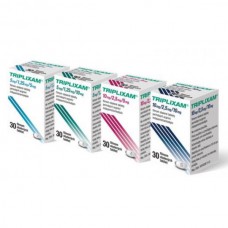Expiration date: 07/2026
PHARMACOKINETICS
Triplism is a combination of three antihypertensive components with complementary mechanisms to control blood pressure in patients with hypertension. Salt of perindopril arginine is an angiotensin converting enzyme indapamide is a diuretic that contains chlorsulfuron, and amlodipine is an inhibitor of the outflow of calcium ions digidropiridinovmi group.
MECHANISM OF ACTION
PERINDOPRIL:
Perindopril is an angiotensin-converting enzyme inhibitor (ACE inhibitor), which converts angiotensin I to angiotensin II, a vasoconstrictor; in addition, this enzyme stimulates the secretion of aldosterone in the adrenal cortex and stimulates the decomposition of bradykinin, a vasodilator, into inactive heptapeptides.
The result is:
- reduction of aldosterone secretion,
- increased plasma renin activity as aldosterone does not send negative information,
- decrease in total vascular resistance, especially in the blood vessels of the muscles and kidneys, without concomitant salt and water retention or reflex tachycardia in chronic treatment.
The antihypertensive effect of perindopril was also noted in patients with low or normal concentration of renin.
Perindopril acts through its active metabolite, perindoprilat. Other metabolites are not active.
Perindopril reduces the work of heart due to:
- vasodilatory effect on veins, probably due to changes in the metabolism of prostaglandins: reduction in preload,
- reduction of total peripheral resistance: reduction of post-loading.
Studies conducted on patients with heart failure have shown:
- decrease in filling pressure of the left and right ventricles,
- reduction of the total resistance of peripheral vessels,
- increased cardiac output and improved cardiac index,
- increased regional blood circulation in the muscle.
The exercise test also showed improvement.
INDAPAMID:
Indapamide is a sulfonamide derivative with an indole ring and is pharmacologically related to a group of thiazide diuretics. Indapamide inhibits sodium reabsorption in the cortical dilution segment. Increases the excretion of sodium and chlorides in the urine and, to a lesser extent, the excretion of potassium and magnesium, thus increasing the volume of urine and providing antihypertensive effect.
AMLODIPINE:
Amlodipine is an inhibitor of calcium ions influx dihydropyridine group (slow channel blocker or antagonist of calcium ions) and inhibits transmembrane influx of calcium ions in the smooth muscles of the heart and blood vessels.
PHARMACODYNAMICS
PERINDOPRIL/INDAPAMIDE:
In patients with hypertension, despite their age, the combination of perindopril / indapamide has a dose-dependent antihypertensive effect on diastolic and systolic blood pressure in the supine or standing position. In clinical studies, the combined use of perindopril and indapamide led to a synergistic antihypertensive action compared to the same drugs taken separately.
PERINDOPRIL:
Perindopril is active in all grades of hypertension: mild, moderate or severe. A decrease in systolic and diastolic blood pressure is noted in the supine and standing positions. Antihypertensive action after a single dose is the maximum between 4 and 6 hours and lasts for 24 hours. There is a high degree of residual blockade of angiotensin-converting enzyme after 24 hours by about 80%.
In patients who respond to treatment, normalization of blood pressure is achieved in a month and is kept without the phenomenon of tachyphylaxis.
Cancellation of treatment does not have a ricochet effect on hypertension.
Perindopril is characterized by vasodilator action and restores the elasticity of the main arteries, corrects histomorphometric changes in the resistance of the arteries and leads to a decrease in left ventricular hypertrophy.
If necessary, add a thiazide diuretic leads to an additive synergy.
The combination of angiotensin-converting enzyme inhibitor with thiazide diuretic reduces the risk of hypokalemia associated with the use of only one diuretic.
INDAPAMID
Indapamide in the form of monotherapy has a 24-hour antihypertensive effect. This action is in doses at which the effect of diuretic is minimal.
Its antihypertensive effect is proportional to the improvement of the vascular wall compliance and decrease of the total and arteriolar peripheral vascular resistance.
Indapamide reduces left ventricular hypertrophy.
When the dose of thiazide and thiazide-like diuretics is exceeded, the antihypertensive effect reaches a plateau, while the side effects continue to increase. If treatment is ineffective, the dose should be increased.
In addition, it has been shown that during the short, medium and long-term use in patients with hypertension indapamide:
- has no effect on lipid metabolism: triglycerides, LDL-cholesterol and HDL-cholesterol,
- does not affect the metabolism of carbohydrates even in hypertensive patients with diabetes.
AMLODIPINE
The mechanism of antihypertensive action of amlodipine is due to the direct relaxing effect on the smooth muscles of blood vessels. The mechanism by which amlodipine reduces angina is not precisely defined, but amlodipine reduces the overall ischemic load due to its two actions.
Amlodipine expands peripheral arterioles and thus reduces the overall peripheral resistance (postnagruzku), with which the heart works. Since the heart rate remains stable, this lowering stress on the heart effect reduces the energy consumption and oxygen demand of the myocardium.
The mechanism of action of amlodipine also probably includes the expansion of the main coronary arteries and coronary arterioles in both normal and ischemic areas. This expansion increases the supply of oxygen to the myocardium in patients with coronary artery spasm (Prinzmetal angina or variant angina).
In patients with hypertension, the dosage once a day leads to clinically significant reductions in blood pressure in the supine position and standing for 24 hours. Due to the slow onset of amlodipine is not prescribed for acute hypertension. Amlodipine does not have an undesirable metabolic effect and does not lead to changes in plasma lipids and thus is suitable for use in patients with asthma, diabetes and gout.
INDICATIONS FOR USE
- for the treatment of essential hypertension in patients taking both perindopril, indapamide and amlodipine in the same doses as in a fixed combination.
METHOD OF APPLICATION AND DOSES
The drug is recommended to take in the morning before meals, 1 time per day.
The combination with a fixed dose is not suitable for initial therapy. If you need to change the dosage, titration of individual components should be carried out.






